
QCW build thread (inc. PCB documentation)
Hydron, Tue Jan 17 2017, 03:55PMIn contrast to my normal method (build something without notes or photographs, get confused later), I've decided to have a go at documenting my QCW project as I build it. Hopefully this will both help others with their builds, and me when I come back and try and figure out what the heck I did!
Basic primary/secondary specs:
- Secondary 110mm dia, 285mm wound length, ~800 turns (guess!) of 0.315mm wire
- 300x75mm spun toroid
- Primary of 9.5mm dia tube, 10 turns, "solenoid" wound on 160mm dia. former. With strike rail, but may remove this later.
- Coupling of ~0.4-0.5 (some adjustment possible)
- 24.8nF primary cap (gives relatively low tank impedance, hopefully works out OK!)
With the above setup (shown below with original ducting toroid, subsequently upgraded to spun), we get the following:
- Primary and secondary resonance both ~260-280kHz
- Upper pole of coupled coils lies at ~360kHz (see graph for measurement of primary impedance with secondary present). If this is not high enough once the coil is loaded by streamers, I will need to change the primary/MMC or secondary (or both) to raise the frequency.
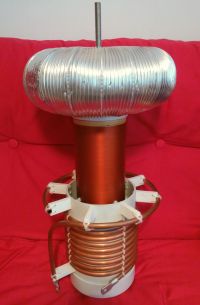
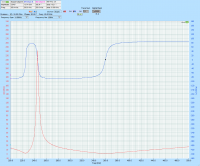
Drive details:
- Initially planning to use phase-shift modulation, will switch to buck modulator if unsuccessful or if I need to push more power than hard-switching will allow.
- MMC split into 8 sections, 4 in parallel on each side of primary coil (see MSPAINT drawing, but ignore the incorrect MMC spec and CT location)
- Each MMC section driven by an independent half bridge. This guarantees reasonable sharing of current and switching losses between parallel bridges.
- 8 half bridge modules on individual PCBs, each with 2x FGH40N60SMD IGBT. May upgrade to FGH60N60SMD (mainly for significantly lower junction-case thermal impedance).
- Each IGBT on an individual heatsink to eliminate insulation pads and their relatively large thermal impedance. Main reason for this is to lower the transient thermal impedance of the system, and thus the delta-temperature seen by the IGBT die during each pulse.

MMC details:
- 24.8nF formed of 8 sections of 12.4nF (2s4p). Each section on individual PCB.
- Each section uses 32x 6.2nF/1600V B32672 TDK EPCOS capacitors in 8p4s configuration for 12.4nF/6.4kV
- 12.8kV DC rating (AC peak rating at low duty cycle is similar - caps are specified for greater than nominal voltage operation) for full MMC
- Current rated at >30A RMS, >600Apk @ ~350kHz
- 256 capacitors total, with 512 bleed resistors (_NOT_ looking forward to soldering this). Caps were cheap though, <40 GBP total.
Gate drive and control:
- Will use a gate drive PCB located under the half bridge modules
- This PCB takes logic-level gate drive signals (will upgrade to RS485 for noise immunity) over shielded ethernet cables, and drives 2x gate drive transformers located on the PCB.
- These transformers have a low inductance connection to the half-bridge PCBs via ribbon cable
- Also takes in outputs from 50:1 commercial CTs located on half of the bridge PCBs (CT outputs connected in parallel to add current together). These are run into a second set of 3 CTs (in series) to give an overall 1000:1 reduction with 3 isolated outputs (for OCD, feedback and monitoring). This is experimental, and may be too high a step-down ratio for a QCW design with it's relatively low current, but is the best I can do with commercial CTs. By using 4 separate CTs and keeping them on the bridge outputs rather than one CT on a primary coil connection we avoid the need to insulate the CT from high voltage (present on both ends of the primary in this design).
- For driving 8 half-bridges, requires a second "slave" PCB with 2 more GDTs on it. This is simply a sub-equiped version of the first PCB, with connection between the two via ribbon cable.
- Gate drive control via a separate PCB, un-designed at this point, but will likely use a combination of a microcontroller and CPLD/FPGA, or a PSoc.
- Driver feature wish-list (i.e. will likely never get around to a lot of these!):
* Phase shift or buck modulator support
* Freewheeling (pulse-skipping) support
* Softstart/phase controlled rectifier support
* PFC voltage/current setpoint control (if I ever build a PFC)
* Control via optical/bluetooth serial link/protocol, rather than the simple interrupter type control
* Readback of values to handheld controller, e.g. peak current, bus voltage etc
* Some sort of MIDI/music support to piss people off with Nyan Cat midis
PCBs:
To do all of the stuff above I intend to build most of the electronics on properly made PCBs. I've documented and release the first 3 that I've designed in the following github repositories:


 .
.- Each has a readme file that should be looked at, and schematics/renders in the "Reference Outputs" folder
- I have concerns over the clearance distances, especially on the GDT PCB. I take no reponsibility if anyone copies what I've done and doesn't treat everything (even low voltage stuff) as live!
- The GDT PCB in particular needs a new revision to be made.
- All 3 are being fabbed right now, so are completely untested as of now!
- Also see thread here:
 for an earlier revision of the IGBT bridge PCB (probably more generally useful, as allows for more heatsink options).
for an earlier revision of the IGBT bridge PCB (probably more generally useful, as allows for more heatsink options).Bridge PCB renders:
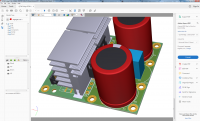
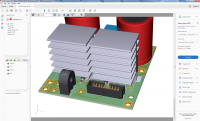
Gate drive PCB renders:
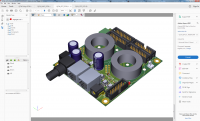

MMC PCB render:
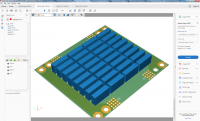
Re: QCW build thread (inc. PCB documentation)
Phillip Slawinski, Thu Jan 26 2017, 01:32PM
Looks like a fun project.
Question: why did you locate the feedback CT on the HV side? Why not pass the four LV leads to one side of the MMC through the CT?
Phillip Slawinski, Thu Jan 26 2017, 01:32PM
Looks like a fun project.
Question: why did you locate the feedback CT on the HV side? Why not pass the four LV leads to one side of the MMC through the CT?
Re: QCW build thread (inc. PCB documentation)
Chris_Dickey, Fri Jan 27 2017, 05:53AM
Seems like Phil didn't read the description.
I just built a dual-bridge coil, using many of the same techniques (MMC paralleling, individual, un-isolated heatsinks, PCB MMC), so this is very familiar.
I also used the same CT scheme you're describing. However, for my first CT stages, I wound my own, in order to get a low ratio. I think the little bit of extra work was worth the overall simplification in wiring. Instead of mounting them on the board, I stuck 'em on aluminum standoffs. This gave me the overall ratio I desired (400:1) and the low turns ratio on the first stage gave plenty of volt-time headroom on the second stage.

Chris_Dickey, Fri Jan 27 2017, 05:53AM
Seems like Phil didn't read the description.
I just built a dual-bridge coil, using many of the same techniques (MMC paralleling, individual, un-isolated heatsinks, PCB MMC), so this is very familiar.
I also used the same CT scheme you're describing. However, for my first CT stages, I wound my own, in order to get a low ratio. I think the little bit of extra work was worth the overall simplification in wiring. Instead of mounting them on the board, I stuck 'em on aluminum standoffs. This gave me the overall ratio I desired (400:1) and the low turns ratio on the first stage gave plenty of volt-time headroom on the second stage.

Re: QCW build thread (inc. PCB documentation)
Hydron, Fri Jan 27 2017, 11:17AM
This was done as it gave me a nice convenient part i could solder to the board without winding, eliminated needing to thread wires through and terminate the output (I intend to pass the bridge output to the MMC with M4 brass standoffs, so keeping it on-PCB helps here), and I had some spare pins on my ribbon cable to use for the output.
The whole scheme with the 1:50 cascaded with the 3x 1:20 CTs gives 1:1000, which is a little bit more than I'd like, but i decided to give it a go as it keeps everything nice and tidy. If needed I'll increase the burden resistors a bit to push up the feedback voltage a bit. Note that I have the ability to look at the gain/phase of the CTs up to 10MHz, so I'll know if it's doing worse than the proven DIY method (which I've verified is _very_ good, with low phase shift and flat gain well past DRSSTC frequencies).
I've attached a picture of the 1:50 CT mounted to a board with heatsinks etc (note that the standoffs are not the final ones I'll use), and will add more later once I've done more of the soldering. Am still waiting on the 1:20CTs so won't be able to test that part of the design till at least next week.
Chris - good to hear that others have gone this route of multi-bridge, split MMC, individual heatsinks etc! Is it working well? What kind of performance are you managing from the coil? I have more devices but less substantial heatsinks than you, so hopefully it works well.
I see that you've used a lot of ceramic caps on your bus - is there a particular part that you found worked well? I've found that it's not so easy to pick them - many parts either have horrible decrease in capacitance (loss of 80% or more) with voltage, or don't specify it at all.

Hydron, Fri Jan 27 2017, 11:17AM
Phillip Slawinski wrote ...
Looks like a fun project.
Question: why did you locate the feedback CT on the HV side? Why not pass the four LV leads to one side of the MMC through the CT?
As Chris mentioned, I actually did locate it on the LV side; the diagram is wrong as noted in my explanation text - I'm putting one (inexpensive commercial high frequency rated) 1:50 CT on each PCB that forms one side of the bridge (4 total), their outputs are combined in parallel to be fed into the second stage CT.Looks like a fun project.
Question: why did you locate the feedback CT on the HV side? Why not pass the four LV leads to one side of the MMC through the CT?
This was done as it gave me a nice convenient part i could solder to the board without winding, eliminated needing to thread wires through and terminate the output (I intend to pass the bridge output to the MMC with M4 brass standoffs, so keeping it on-PCB helps here), and I had some spare pins on my ribbon cable to use for the output.
The whole scheme with the 1:50 cascaded with the 3x 1:20 CTs gives 1:1000, which is a little bit more than I'd like, but i decided to give it a go as it keeps everything nice and tidy. If needed I'll increase the burden resistors a bit to push up the feedback voltage a bit. Note that I have the ability to look at the gain/phase of the CTs up to 10MHz, so I'll know if it's doing worse than the proven DIY method (which I've verified is _very_ good, with low phase shift and flat gain well past DRSSTC frequencies).
I've attached a picture of the 1:50 CT mounted to a board with heatsinks etc (note that the standoffs are not the final ones I'll use), and will add more later once I've done more of the soldering. Am still waiting on the 1:20CTs so won't be able to test that part of the design till at least next week.
Chris - good to hear that others have gone this route of multi-bridge, split MMC, individual heatsinks etc! Is it working well? What kind of performance are you managing from the coil? I have more devices but less substantial heatsinks than you, so hopefully it works well.
I see that you've used a lot of ceramic caps on your bus - is there a particular part that you found worked well? I've found that it's not so easy to pick them - many parts either have horrible decrease in capacitance (loss of 80% or more) with voltage, or don't specify it at all.

Re: QCW build thread (inc. PCB documentation)
Chris_Dickey, Sat Jan 28 2017, 06:41AM
The pic I sent is an old one; I've moved to film from ceramic, but the boards are essentially the same. I became aware of the problems with voltage effects, and I had some failures that were probably caused by stress cracking of the caps.
Performance of the coil has been generally decent. It behaves essentially like a lower-power version of Phil's "skinny coil". I wanted good thermal performance, but without water cooling.

I've also been toying with the idea of restoring a short-lived coil of mine with the same bridge design, but can never seem to get around to it.
Chris_Dickey, Sat Jan 28 2017, 06:41AM
The pic I sent is an old one; I've moved to film from ceramic, but the boards are essentially the same. I became aware of the problems with voltage effects, and I had some failures that were probably caused by stress cracking of the caps.
Performance of the coil has been generally decent. It behaves essentially like a lower-power version of Phil's "skinny coil". I wanted good thermal performance, but without water cooling.

I've also been toying with the idea of restoring a short-lived coil of mine with the same bridge design, but can never seem to get around to it.
Print this page